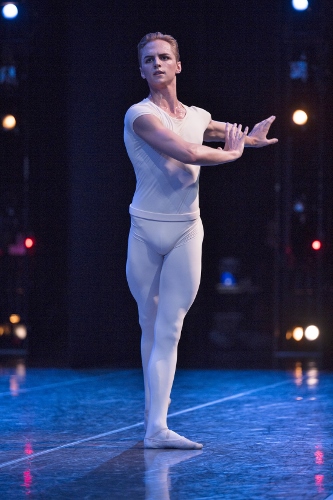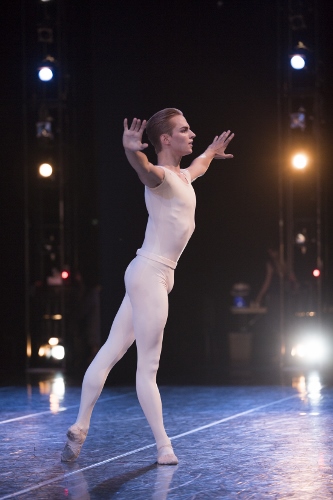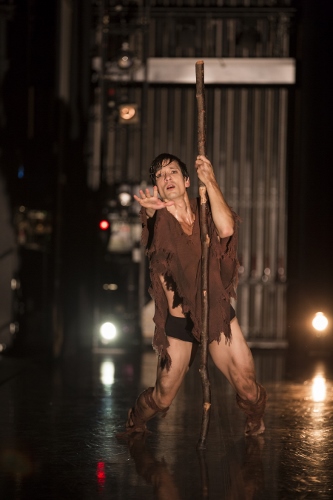|
 |
|
|
 |
 |
Jerome Robbins' Male Solos
Jerome Robbins Centennial Celebration
Tuesday, October 2, 2018
Presenter: Peter Boal, Director, Pacific Northwest Ballet
Performers: James Moore, principal dancer, PNB
Lucien Postlewaite, principal dancer, PNB
Dylan Wald, corps de ballet dancer, PNB
Christina Siemens, pianist and vocalist
Program—excerpts from and discussion of:
Prodigal Son, 1929 Ballets Russes/ PNB première 1984, chor. George Balanchine, mus. Sergei Prokofiev, libretto Boris Kochno. Danced by James Moore.
Dances at a Gathering, 1969/2009, chor. Jerome Robbins, mus. Frédéric Chopin. Danced by Lucien Postlewaite.
Opus 19/The Dreamer, 1979/2017, chor. Jerome Robbins, mus. Sergei Prokofiev. Danced by Dylan Wald.
A “lost” solo, originally intended for Ives, Songs, 1987, chor. Jerome Robbins, mus. Charles Ives— “A Farewell to Land,” words George Gordon, Lord Byron (Childe Harold's “Good Night” stanza 1 of ten 8-line stanzas, in “Childe Harold's Pilgrimage,” 1812). Danced by James Moore.Peter Boal (b. 1965), much esteemed in his dancing days as an example of male classicism at its finest, has directed the Pacific Northwest Ballet and its associated school since 2005. He arrived in the job the year he retired as a principal dancer at the New York City Ballet, which he joined in 1983 (performing for the first time as a full-fledged company member on April 30th of that year, the day that George Balanchine died), following some eight years as a student at the School of American Ballet—where he himself began to teach in the 1990s. Toward the end of his NYCB career, I also saw him perform in the works of several modern dance choreographers, most notably in Molissa Fenley's solo to the entire score of Igor Stravinsky's The Rite of Spring. (It was Mr. Boal's performance that lead me to appreciate that solo, which I'd already seen the choreographer herself perform.) In a June 2005 New York Times “Critic's Notebook” column, assessing Mr. Boal's dance career on the occasion of his NYCB retirement, Jennifer Dunning reminded readers that Mr. Boal had to learn acting after he became a professional dancer. Once he mastered it, she wrote, his 1996 performance of a passage from the title role of Balanchine's Orpheus, where the dancer is required to move an audience through stillness, “was theater itself.” She also wrote that Mr. Boal “embodied the dark, lost heart of the alienated searcher in [Jerome] Robbins's Opus 19/The Dreamer,” to Sergei Prokofiev's Violin Concerto No. 1 in D Major. At this Works & Process program, part of the birth centenary year of Robbins, Mr. Boal explained that of the roster of roles he worked on with Robbins as either the choreographer or the coach, Opus 19/The Dreamer was the part that Robbins kept reworking, wouldn't let go. It was also the subject of what Mr. Boal described as his best moment with Robbins ever, that is, when, after one performance, Robbins, weeping, came up to him and wordlessly kissed his forehead. (The part was originally made for Mikhail Baryshnikov, who suggested to Mr. Boal that it was, for Robbins, at least partially autobiographical.) As a demonstration of Mr. Boal's understanding of the choreography and of his extraordinary coaching ability, Dylan Wald—a lean and long-limbed PNB corps dancer who already has a lustrous classical technique and (perhaps thanks in part to Mr. Boal) a subtle sense of character—showed us the Dreamer awaking, his arms (in Mr. Boal's words) “fractured into a million pieces.” Their continuous changes of level and position, as if they were being hammered into sections, mysteriously established a continuity one felt without optical evidence for the feeling. Throughout the program, Mr. Boal conveyed the message that Robbins's ballets—regardless of whether a narrative is present in the program or not—were, for the choreographer, associated at nearly every point with a range of images, symbolic actions, even expressive statements. Over nearly sixty years, I've been able to see Robbins's choreography and stage direction (for several companies with whom he worked and for Broadway shows) and to study his films, and I've read the four book-length Robbins biographies: I know that acting and production ideas were very important to him. However, it was a dazzling revelation to follow Mr. Boal's moment-by-moment analysis of, for instance, the opening entrance in Dances at a Gathering by the Boy in Brown (learned by Mr. Boal directly from the choreographer, alongside Jeffrey Edwards and Damian Woetzel, and danced at the Guggenheim with sculptural clarity by PNB's Lucien Postlewaite). Mr. Boal drew our attention to the several moments in the solo when the Boy in Brown is called out to by “ghosts” and his flashing pivots to acknowledge them in response. Also revealing were Robbins's images concerning the opening moments: that the Boy in Brown walks in from the downstage left corner as if he'd just come out of the audience—as if he were us; that his kneeling to place his open palm on the stage is meant to evoke a deeply personal memory not only in the figure himself but also in each audience member. Mr. Boal recounted Robbins's examples from rehearsal: a return to a long-ago summer place, to the beaches of Normandy, to the ballet studio where one studied as a youth. When this 1969 masterpiece was relatively new, Robbins took public issue with Edwin Denby for imagining a specific scenario, evocative of WWII Poland, to Dances at a Gathering. Was it possible that, instead of Denby being “wrong,” he was too close to the molten truth? Mr. Boal's analysis of the choreography, according to the imagery that Robbins used to convey it to Mr. Boal and his NYCB colleagues, demonstrated that Robbins wanted control over the stories that dancers might tell themselves about the movement he gave them, as well as complete control over the dance actions themselves. Even when his dances are presented as being “storyless” (that is, they have no specific narrative in the program), they were telling stories to the choreographer, and the content of those stories—whose details could shift from cast to cast or even day to day—was, ultimately, part of the choreography yet only knowable according to the suggestive clues the choreographer might dispense. And, as Mr. Boal explained, Robbins dispensed them to a selected few, a sort of company within the company. (Mr. Boal put the number of Robbins regulars during his own time at NYCB at about fifteen, in a company that then numbered 114 dancers.) However, in Mr. Boal's experience, Robbins's urge to control the dancers relaxed during the 1980s, in particular with works that Mr. Boal nicknamed “The Angel Ballets”: In Memory Of. . . (Alban Berg, 1985) and Quiet City (Aaron Copland, 1986; dedicated to the memory of dancer Joseph Duell, who had taken his life, age 29, earlier that year and who had been in the original cast of the Berg ballet). These works were made in a time when Robbins suffered the losses of Balanchine and Edith Weissman (Robbins's longtime secretary) and, as Mr. Boal reminded us, had lost many friends to AIDS as well. (In a 1985 interview with Alan Kriegsman, then the dance critic of The Washington Post, Robbins insisted that he wasn't thinking of anyone in particular—most especially not Balanchine—when he made In Memory Of. . . .) In making Quiet City, Robbins told Mr. Boal and the other dancers in the small cast that he was going to show them “some material” to work on, adding, “When you have that done, show me what's next.” Mr. Boal found that empowering, especially as he felt that he was not one of the choreographer's favorites. “He asked us as collaborators”—not a relationship that Robbins was known to maintain very often with dancers in the studio. At the Guggenheim evening, PNB principal James Moore performed solos that were quite special to Mr. Boal. Two were from the title role in Balanchine's 1929 Prodigal Son, a story ballet that Balanchine revived for Robbins, by legend a brilliant Prodigal, in 1950, in a production where the choreographer-coach also played the Father in some performances. (Mr. Boal made his own debut in the title part in 1990.) “Peter [Martins, then the ballet master in chief of NYCB] asked me if it would be okay for Jerome Robbins to coach me in “Prodigal,” Mr. Boal said. It was okay. Robbins “cleared the room for a week of daily rehearsals,” and Messrs Boal and Moore took the Guggenheim audience through a bit of one of them. Mr. Boal, impersonating Robbins, asked Mr. Moor, impersonating Mr. Boal, to make his first entrance, from the family tent. Mr. Moore stepped forward, one step, and he was stopped and asked to do it again. And again Mr. Boal-as-Robbins posed questions for Mr. Moore-as-Mr. Boal: What did the Prodigal have for breakfast? What time did he wake up? When did he plan to take the trip to the fleshpot city? When the Prodigal goes over to check his inheritance (the wine jars and trumpet props) does he do so with delight? Familiarity? Mr. Boal also discussed the Prodigal's last entrance, when, his legs broken, he poles himself along with a huge staff until he sees a fence very like the one around the family home he'd abandoned. Mr. Boal directed the Prodigal to make slow connections that the audience can see. “If this fence were mine, then my house would be over there. . . .” At the end of the program, Mr. Boal and Mr. Moore realized a “lost” solo from Robbins's Ives, Songs (Charles Ives, 1987), another memory ballet (in this case, Ives's memories from a turn-of-the-twentieth- century-America small town) and, like other Robbins works from the late 1980s, a ballet shot through with a theme of impending mortality. This solo, one of five for the Ives work that was built on Mr. Boal, was cut by Robbins before the première and never performed. The plangent song, performed by pianist Christina Siemens, has lyrics by Byron, an address to his native land by a speaker who is going into permanent exile. The choreography is essentially a slow procession for one on a diagonal, going from downstage (that is, a location where the dancer is affiliated with the audience) to upstage (where the figure is increasingly separated from society). Mr. Boal explained that the dancer is on a raft, that his circling his own axis in small steps represents the raft suddenly caught in an eddy, that the choreographer of this little voyage into desolation had parts of his personality that were tortured but that he was “a complete artist, a complete human being.” Mr. Boal explained that he first worked with Robbins when Mr. Boal was a ten-year-old student at the School of American Ballet. The work, for NYCB's 1975 Ravel Festival, was Mother Goose. Mr. Boal was Cupid, and his mission was to lead the Prince to break the spell that has caused the Princess to sleep for a century. The pair has to navigate wetlands, and Mr. Boal wasn't persuading Robbins that he, Cupid, was leading the Prince through a meadowland. “When you lead Prince Charming to the Princess, you have to clear the reeds,” Robbins told Mr. Boal's Cupid. “Not only with your arm but your body. Remember that you're an Indian scout.” “Indian?” Mr. Boal wondered silently. “Did he mean from India?” But Mr. Boal didn't ask aloud. “Remember that, every time you put your foot down, to be sure that there is no twig that might break under your foot.” Mr. Boal demonstrated. Mr. Boal got it, and it was Mission Accomplished for Cupid.
 Pacific Northwest Ballet principal dancer Lucien Postlewaite in Jerome Robbins’ "Dances at a Gathering". Photo © & courtesy of Angela Sterling |
|
 Pacific Northwest Ballet corps de ballet dancer Dylan Wald in Jerome Robbins’ "Opus 19/The Dreamer." Photo © & courtesy of Angela Sterling |
|
 Pacific Northwest Ballet corps de ballet dancer Dylan Wald in Jerome Robbins’ "Opus 19/The Dreamer." Photo © & courtesy of Angela Sterling |
|
 Pacific Northwest Ballet principal dancer James Moore in "Prodigal Son," choreography by George Balanchine © The George Balanchine Trust. Photo © & courtesy of Angela Sterling |
|
|
|





